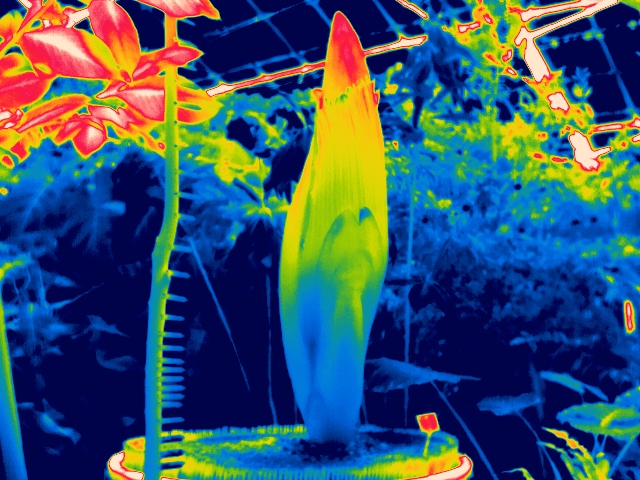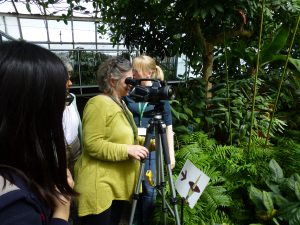A small army of staff and volunteers, dubbed the ‘Titan Arum Army’, is sweltering alongside New Reekie to help explain this extraordinary tropical plant to visitors. However, heat is a central part of this plants story in more ways than one…

Marianne Farish from SRUC with the thermal imaging camera used to visualise the temperature of New Reekie.
Yesterday, on June 17th, Marianne Farish from SRUC, just outside Edinburgh, was a special visitor to see New Reekie. Part of her work on animal health involves monitoring temperature with a sophisticated thermal camera. Temperature changes in the bodies of animals can indicate infections or other problems. Marianne heard about New Reekie on the news and was intrigued to discover that the central part of the flower head heats up. When she asked if she could bring her camera along we jumped at the opportunity.
The science behind the FLIR SC620 camera is that the lens only lets infrared light (heat) through, and clever software then converts this pattern of varying heat into a gradient of colours that we can see.
The reason that being able to see the variations in temperature across the titan arum is so interesting is that on both the first and second night of opening the flower head will heat up to help the pollination process. This phenomenon was only documented for the first time by work at the Botanical Gardens of the University of Bonn in 2006. Incredible as it might seem, many plants in the same family as titan arum – Araceae – produce heat in the same way. It is likely this heating happens for two reasons:
- to disperse the smell chemicals that attract potential pollinators (carrion beetles and flies)
- to reward insect pollinators by helping them get to operating temperature (insects are cold blooded)

Thermal image of titan arum (17th June) taken with FLIR SC620 camera showing temperature gradients caused by sunlight. Copyright: SRUC 2015.
What the work at Bonn has shown is that around 8pm on the first night of opening the central column (spadix) heats up to around 36 degrees centigrade and will be around 10 degrees warmer than the surrounding temperature. This heating happens in waves, with peak temperature reached around midnight. Waves of smell were noted to coincide with heating so for the titan arum the ‘smell boosting’ hypothesis seems to be supported.

Staff enjoying the thermal camera that will hopefully be employed to monitor temperature changes during flowering (estimated to be a week to 10 days away).
The Bonn team has also documented heating of the male flowers on the second night of opening. Essentially what is happening is that the male and female flowers at the base of the spadix mature on consecutive days to reduce the chance of self-fertilisation. Female flowers are receptive on the first night and male flowers produce pollen on the second night. What the plant is doing is sending out a massive smell signal on the first night to bring in insects that have just left another titan arum (possibly miles away) that has released its pollen. The pollen covered insect will arrive and deposit pollen on receptive female flowers. The insect will stay inside the flower chamber, around the base of the spadix, for 24 hours, only leaving when it has again been given a fresh dusting of pollen ready to repeat the cycle with another flower.
This whole process is an example of deception as the flower tricks the insect into thinking it has found some rotting flesh by sending out a smell that is chemically very similar. However, it is possible that the insects do gain some benefit. Many insects eat pollen so some food is available. Another suggestion is that the insects might be meeting their mates in the flower chamber. Perhaps the heat and smell is a turn-on for carrion beetles? At least it is a relatively safe place to mate as few animals can access the flower chamber and fewer still can tolerate the smell!
